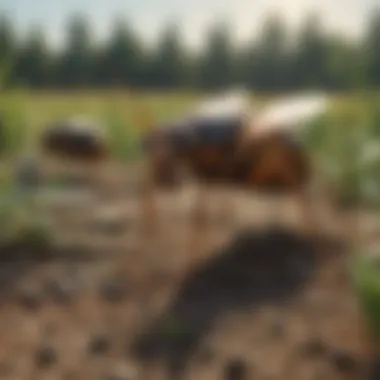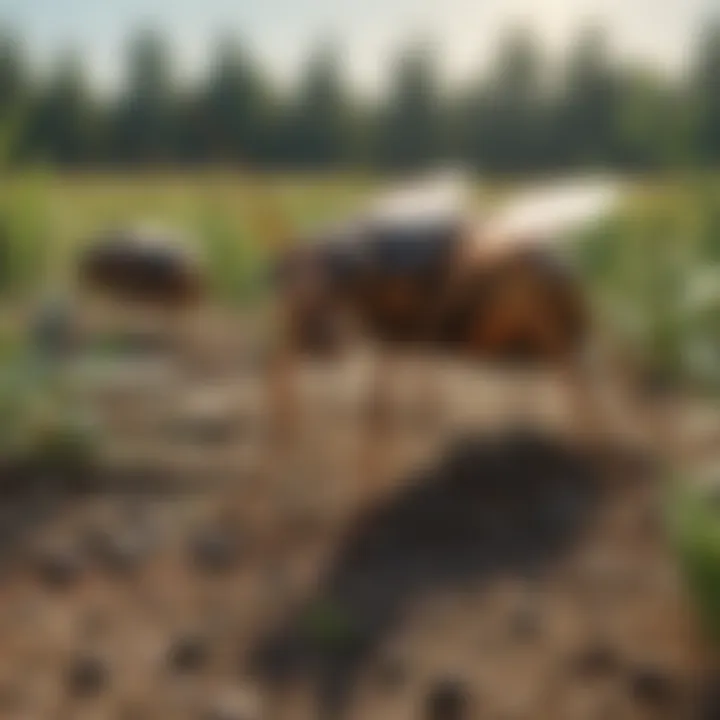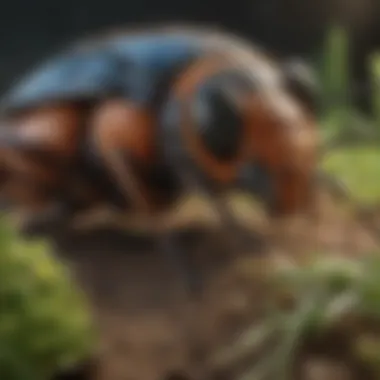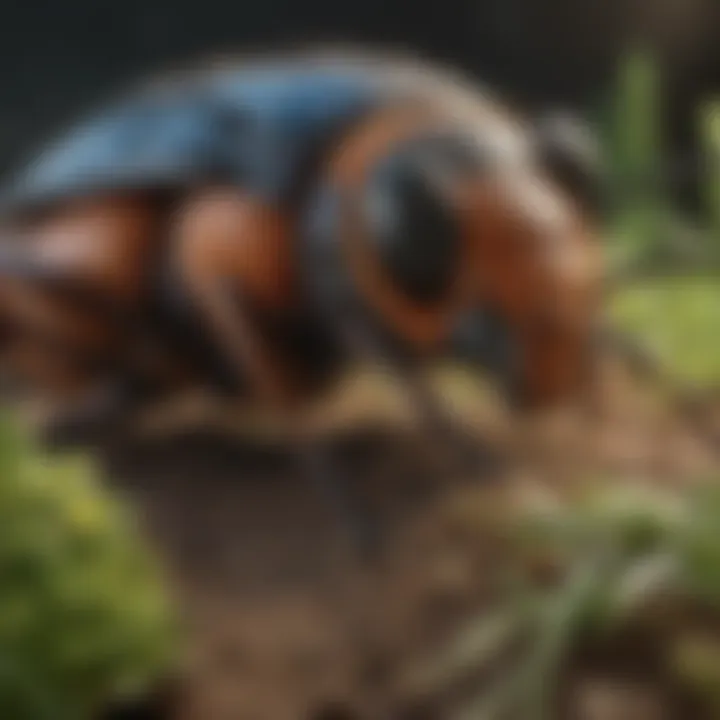Sustainable Pest Control Strategies for Farmers


Intro
Effective pest control is an essential component of agriculture and horticulture. It not only ensures healthy crops but also contributes to sustainable farming practices. This guide explores the diverse strategies available for pest management while highlighting the significance of adopting environmentally responsible methods. By understanding pests and their ecosystems, farmers and enthusiasts can protect their yield and the environment alike.
Key Concepts and Terminology
Understanding pest control requires familiarity with certain key concepts and terminology.
Basic Definitions
Pests are organisms that harm plants, animals, or humans. They can be insects, rodents, fungi, or weeds. Integrated Pest Management (IPM) is a holistic approach that combines multiple strategies to manage pest populations in an environmentally friendly way.
Historical Context
Historically, pest control methods have evolved from the use of harmful chemicals to more sustainable techniques. Early methods included natural predators and simple physical barriers. With advancements in research, the principles of IPM emerged in the late 20th century, incorporating natural processes and biological control into traditional farming practices. This shift reflects a growing awareness of the ecological impacts associated with conventional pest management.
Recent Innovations and Trends
The pest control landscape is continually evolving. New innovations and trends are shaping the methods by which farmers manage pests in a sustainable manner.
Technological Advancements
Modern technology has introduced various tools and solutions for pest control. Tools such as drones and sensors allow for precise monitoring of pest activities. These technologies enable farmers to identify infestations early and respond effectively, minimizing damage to crops.
Sustainable Practices
Sustainable pest management practices are gaining momentum. Techniques such as crop rotation and companion planting enhance biodiversity and optimize land use. Additionally, the use of organic substances, such as neem oil or diatomaceous earth, shows promise as eco-friendly alternatives to traditional chemical pesticides.
Practical Applications and Techniques
For effective pest management, practical applications are crucial. Here are a few strategies to consider:
Step-by-step Guides
- Identify Plant Species: Understanding what you are growing helps in recognizing potential pests specific to those plants.
- Monitor Regularly: Frequent checks allow early detection of pest activity.
- Implement IPM: Apply integrated practices suited for the specific pests detected.
- Evaluate: After implementing control measures, evaluate their effectiveness to refine future strategies.
Case Studies
Case studies demonstrate the success of sustainable pest management practices. For example, a study involving grape growers in California found that implementing integrated pest management reduced pest-related losses by over 30%. These methods included the use of pheromone traps and attracting beneficial insects, effectively managing pest populations while preserving the health of the vineyards.
"Sustainable pest management is not just a practice; it is a philosophy that aligns agriculture with ecological responsibility."
Through adopting these techniques, farmers can improve their yields while supporting a healthier environment.
Preface to Pest Control
Pest control holds significant relevance within agriculture. Through effective management strategies, farmers can protect their crops from pests that threaten productivity and yield. Understanding this field is foundational for both conventional and organic practices.
Understanding the Role of Pests
Pests play various roles within ecosystems. Not all pests are detrimental; some can even provide benefits. For instance, certain insects assist in pollination, while others help decompose organic matter. However, when these organisms multiply excessively, they can cause serious harm. They may lead to reduced crop yields, contaminated food supplies, or increased costs of production. Therefore, recognizing the duality of pest roles is essential.
Effective pest control strategies focus on reducing the negative impacts of harmful pests while appreciating the ecological contributions of beneficial ones. This balance is key to sustaining agricultural practices.
Historical Context of Pest Control
The history of pest control traces back to ancient civilizations. Farmers have always sought ways to protect their harvests from damage. Initially, methods were rudimentary, such as manual removal or the use of natural barriers. As agriculture evolved, so did pest management techniques.
In the 19th century, the introduction of chemical pesticides marked a significant shift in pest control methods. While these provided effective short-term solutions, they also raised concerns about environmental impact and human health. Over time, this awareness led to the development of Integrated Pest Management (IPM) practices. IPM merges traditional methods with modern innovations, focusing on sustainable long-term strategies.
Understanding the historical context allows modern practitioners to learn from past successes and mistakes. This knowledge informs current practices and promotes the development of more sustainable pest management solutions.
The Necessity of Pest Management
Pest management plays a critical role in modern agriculture and horticulture. It addresses the growing challenges posed by pests, which can severely impact crop yield and quality. Understanding the necessity of pest management requires examining several key factors, including the impact pests have on agriculture, the economic consequences they entail, and the potential public health risks they pose.
Impact of Pests on Agriculture
Pests affect agricultural productivity through various means. They consume crops, vector diseases, and create favorable conditions for fungi and bacteria that can harm plants. The consequences of pest infestations can be dire:
- Crop Loss: Insect pests like aphids and locusts can cause significant damage to plants, leading to reduced yields and quality.
- Plant Diseases: Pests often spread diseases. For example, the corn earworm can transmit viruses that devastate maize crops.
- Resource Drain: Farmers are compelled to allocate resources towards control measures. This can divert funds from other critical agricultural practices.
Addressing pest-related issues helps ensure that crop production remains sustainable and viable. Without effective pest management, food supplies can dwindle, threatening food security.
Economic Consequences


The economic impact of pests extends beyond just direct agricultural losses. The costs of pest control and the economic ripple effects are multifaceted:
- Increased Costs: Farmers must invest in pesticides and other control measures, which can increase production costs significantly.
- Market Prices: Crop losses can lead to reduced supply in markets, causing prices to soar. This affects consumers and can lead to market volatility.
- Export Challenges: Countries with severe pest issues often face restrictions in exporting produce. This can hinder economic growth in regions reliant on agricultural exports.
"Effective pest management is not just about controlling pests; it's about ensuring economic stability and security in agriculture."
Public Health Risks
Pests not only threaten crops but can also pose serious health risks to communities. The public health implications are crucial:
- Vector Species: Many pests act as vectors for diseases that can affect humans and livestock. For instance, mosquitoes transmit malaria and dengue fever.
- Contaminated Food: Pest infestations can lead to contamination of food supplies. Rodents and insects can carry pathogens, exposing humans to potential health risks.
- Environmental Health: The usage of chemical pesticides can have downstream effects on ecosystems, leading to health risks for humans as well as non-target species.
In summary, the necessity of pest management is a multi-dimensional issue encompassing agricultural effectiveness, economic stability, and public health safety. It is vital that farmers and stakeholders adopt sustainable pest management practices to ensure long-term viability and safety in agricultural endeavors.
Integrated Pest Management (IPM) Principles
Integrated Pest Management (IPM) represents a strategic and comprehensive approach to pest control. It focuses on minimizing the impact of pests through a combination of techniques that are environmentally sound and economically viable. IPM is crucial as it encourages sustainable management practices while addressing the underlying causes of pest issues. By integrating various control methods, IPM not only protects crops but also conserves beneficial organisms within the ecosystem.
The benefits of adopting IPM principles are multifaceted. First, it enhances crop yield and quality. Second, it reduces the reliance on chemical pesticides, which can have detrimental effects on the environment and human health. Third, IPM fosters resilience in agricultural systems, making them less susceptible to pest outbreaks. Moreover, these practices can lead to cost savings for farmers due to decreased pesticide usage.
Overview of IPM
The overarching aim of IPM is to achieve long-term management of pest populations while reducing risks to human health and the environment. This approach involves a carefully designed and executed plan that takes into account the lifecycle of pests, their natural enemies, and the specific crops grown. Essential components of IPM may include cultural control measures, biological suppressants, physical and mechanical controls, and judicious use of chemicals when necessary.
Furthermore, IPM is not a one-size-fits-all solution; it requires ongoing evaluation and adaptation to local conditions. Farmers must observe conditions in their fields continually and adjust management strategies based on real-time information on pest presence and status.
Pest Monitoring and Identification
Proper monitoring is foundational to effective IPM. The initial step involves regularly checking crops for signs of pest activity. This may include scouting fields to identify pests and assess damage levels. Knowing which pests are present helps determine the appropriate course of action.
Identification is equally important. Different pests have varied thresholds for damage and may respond differently to management practices. Misidentifying a pest could lead to ineffective treatments and increased crop damage. Therefore, farmers should utilize reliable identification guides or seek assistance from local agricultural extensions.
Threshold Levels for Intervention
The concept of threshold levels is crucial for deciding when intervention is necessary. Threshold levels refer to the pest population density at which the potential economic damage would outweigh the cost of control measures.
Establishing these levels is essential for preventing unnecessary interventions. Many farmers might feel the urge to control pests at any sight of them, but IPM advocates for a more strategic approach. For instance, if pest populations remain below a certain threshold, it may be more beneficial to wait and observe rather than take immediate action.
"The essence of Integrated Pest Management lies in its multifaceted approach, combining various pest management techniques for sustainable outcomes."
Farmers who implement IPM practices benefit from increased resilience and adaptability in their pest control strategies.
Common Agricultural Pests
Understanding common agricultural pests is crucial for effective pest management. These pests can cause significant damage to crop yields and quality. Farmers and horticulturists must recognize and address pest issues swiftly to ensure the sustainability of their practices. Each pest presents unique challenges and requires tailored strategies for control.
Insect Pests
Insect pests are among the most prevalent threats to agricultural productivity. They can cause direct harm by feeding on crops or indirectly by spreading diseases. Common insect pests include aphids, caterpillars, and beetles.
- Aphids: These small insects can reproduce rapidly and damage plants by sucking sap, which leads to wilting and stunted growth.
- Caterpillars: They are the larval stage of moths and butterflies. They can consume large amounts of foliage, jeopardizing the plant's survival.
- Beetles: Many beetle species, such as the Colorado potato beetle, can result in considerable crop loss if not controlled.
Identifying the type of insect pest is essential for implementing appropriate management strategies. Integrated pest management (IPM) strategies often include cultural practices, biological control, and sometimes chemical intervention when necessary.
Weeds and Their Management
Weeds are often ignored but can be significant challengers to sustainable agriculture. They compete with crops for nutrients, water, and light, potentially diminishing yields. Managing weeds effectively is an integral part of pest control programs.
- Cultural Practices: Crop rotation, cover cropping, and mulching can help suppress weed growth. These practices promote healthy crops while reducing the need for chemical herbicides.
- Mechanical Control: This can include physical removal or mowing, which can manage weed populations without chemical inputs.
- Chemical Herbicides: Although effective, they need to be applied carefully to minimize environmental impact and resistance development.
A well-rounded weed management program considers the specific types of weeds present and their growth habits as well. Understanding these aspects aids in the formulation of an effective management plan.
Diseases and Pathogens
Plant diseases caused by pathogens such as fungi, bacteria, and viruses can devastate crops. Rapid identification and understanding of these diseases are vital for effective control strategies.
- Fungi: They are a common cause of infection, leading to conditions like powdery mildew and root rot. Early detection and treatment can help mitigate spread.
- Bacteria: These can cause blights and wilts. Managing soil health is key to preventing bacterial diseases.
- Viruses: Often transmitted by insects, viral diseases can limit crop production significantly.
Preventive measures, including resistant crop varieties and biosecurity practices, can help in reducing the risk of disease outbreaks. Farmers need to monitor their crops regularly for any signs of disease to facilitate prompt intervention.
Effective pest management lies in understanding the life cycles and impact of common agricultural pests. By employing diverse and sustainable control measures, farmers can protect their crops while promoting an environmentally friendly approach.
Preventive Pest Control Measures
Preventive pest control measures play a crucial role in sustainable pest management. They encompass practices and strategies designed to avert pest problems before they escalate. By adopting these measures, farmers and horticulturists can reduce pest populations, minimize chemical use, and foster a healthier ecosystem.
Cultural Practices


Cultural practices refer to the agricultural techniques that can be employed to create an environment less conducive to pest infestations. This includes crop rotation, selecting resistant plant varieties, and adjusting planting dates. These methods not only disrupt the life cycles of pests but also promote plant health.
- Crop Rotation: Alternating crops helps prevent pests from establishing and multiplying in the same area.
- Diverse Planting: Growing a variety of plants can confuse pests and attract beneficial insects that prey on harmful ones.
- Soil Health Management: Healthy soil leads to strong plants that are more resilient to pest attacks. Practices like composting and cover cropping improve soil structure and fertility.
Regular monitoring and record-keeping can help identify which practices yield the best results over time.
Biological Control Options
Biological control involves the use of natural predators or parasites to keep pest populations in check. This method aligns with sustainable practices and reduces reliance on synthetic chemicals. Key elements include:
- Beneficial Insects: Introducing species like ladybugs or parasitic wasps can effectively control aphids and other pests.
- Microbial Agents: Utilizing microorganisms such as Bacillus thuringiensis can help manage caterpillar pests without harming beneficial insects.
- Natural Predators: Encouraging birds and other animals that prey on pests fosters a balanced ecosystem, reducing the need for pesticides.
It's important to evaluate local ecosystems to ensure the natural controls are effective and will not disrupt existing balances.
Physical Barriers and Traps
Physical barriers and traps serve as proactive measures to keep unwanted pests away from crops. These methods can be highly effective and eco-friendly.
- Row Covers: Lightweight fabrics can protect young plants from insects while allowing sunlight and moisture.
- Sticky Traps: Placing traps around the field can monitor pest populations and manage infestations before they spread.
- Fencing: Simple barriers like fences can deter larger pests such as rabbits and deer from entering cultivated areas.
Implementing these preventive measures not only protects crops but also reduces long-term pest management costs.
Employing a combination of cultural practices, biological control, and physical barriers is essential in creating a proactive pest management plan. Sustainable practices lower reliance on harmful chemicals and benefit the entire ecosystem.
Chemical Control of Pests
Chemical control remains a vital component of pest management strategies. Though integrated pest management promotes a balanced approach, situations can arise where chemical interventions are necessary. Understanding when and how to use these substances effectively is crucial. As we delve into the specifics, it is significant to recognize both the advantages and the possible downsides of employing chemical controls for pest issues.
With the potential to swiftly alleviate pest-induced damage, chemical products can provide immediate and sometimes enduring relief. This efficacy, however, does not come without its complexities. New awareness about environmental sustainability and health impacts necessitates a careful consideration of the types and methods of application. It's vital to prioritize safety, effectiveness, and ecological implications when selecting and using pesticides.
Types of Pesticides
Pesticides can be categorized into several distinct classes, each with unique characteristics and purposes. Understanding these categories is fundamental for effective pest control. Here are the main types:
- Insecticides: Target insects, effectively controlling populations that can harm crops. These products focus on specific life stages and may not affect non-target species if used properly.
- Herbicides: Designed to manage unwanted vegetation, herbicides help ensure crops have the needed resources without competition.
- Fungicides: Combat fungal diseases that may devastate plants. These are critical in maintaining the health of crops susceptible to pathogens.
- Rodenticides: Used against rodent populations that can lead to significant losses in storage and field conditions.
When selecting a pesticide, understanding the biology of the target pest and its habits helps decide the best chemical control to opt for.
Safe Application Practices
Applying pesticides safely is crucial for minimizing risks to human health, non-target organisms, and the environment. Here are key practices:
- Read Labels: Always read and follow label instructions to ensure safe and effective use.
- Use Personal Protective Equipment (PPE): Equip yourself with gloves, masks, and protective eyewear when handling chemicals to prevent exposure.
- Time of Application: Apply pesticides during non-windy periods to reduce drift and in the early morning or late evening when pollinators are less active.
- Calibration of Equipment: Ensure that application equipment is calibrated correctly to deliver the appropriate doses, minimizing excess.
By adhering to these practices, the risks associated with pesticide use can be significantly minimized.
Environmental Considerations
The use of chemical pesticides poses notable environmental considerations. Key aspects to take into note include:
- Non-target Species: Pesticides can harm beneficial insects, like pollinators, leading to ecological imbalances.
- Soil Health: Chemicals can affect soil microorganisms. Healthy soil is essential for plant growth, and its disruption can lead to longer-term agricultural issues.
- Water Contamination: Runoff from treated areas can introduce harmful chemicals into waterways, affecting aquatic life and drinking water supplies.
"Responsible use of chemicals in pest management is essential. Balancing efficacy with environmental safety creates a sustainable pathway for agriculture."
Farmers and agricultural experts must regularly evaluate the long-term effects of their chemical pest control methods and consider integrating alternatives where applicable.
Evaluating Pest Control Effectiveness
Evaluating pest control effectiveness is a critical component in the realm of sustainable pest management. It allows farmers and agricultural enthusiasts to assess the success of their pest control efforts. A thoughtful evaluation process ensures that the strategies employed are not only effective but also environmentally sound. By systematically measuring outcomes, one can make data-driven decisions that enhance pest management practices.
The benefits of evaluating pest control effectiveness are manifold. Firstly, it provides insights into which methods yield the best results, guiding future choices. Secondly, an evaluation can pinpoint areas that require adjustment. Finally, such assessments bolster confidence among stakeholders in agricultural settings, reaffirming the commitment to sustainable practices.
Measuring Outcomes
Measuring outcomes involves systematic data collection and analysis to determine the success of pest control methods. This can include metrics such as pest population density, crop yield, and overall health of the ecosystem. Collecting this data helps in establishing a baseline against which future efforts can be compared.
The following are essential approaches to measuring outcomes:
- Monitoring Pest Populations: Regularly assess the pest populations in the field through visual inspections or traps. This helps in identifying the pest species and evaluating their numbers at various times.
- Yield Assessment: Monitor and compare crop yields before and after implementing pest control measures. A significant increase in yield can indicate successful pest control.
- Economic Analysis: Evaluate the cost-effectiveness of pest control methods, including initial costs, ongoing expenses, and the financial benefits gained from improved yields.
Additionally, utilizing technology such as precision agriculture tools can provide more accurate data to analyze pest control effectiveness. By compiling this information, farmers can draw conclusions necessary for making informed decisions.
Adjusting Strategies
Adjusting strategies is vital to refine pest management efforts continuously. The landscape of agriculture is dynamic, with factors such as climate change, pest evolution, and market demands affecting pest populations and control methods. This necessitates a flexible approach that can adapt based on evaluation outcomes.
When adjusting strategies, consider:


- Data-Driven Decisions: Use the data collected during the measuring outcomes phase to identify what works and what doesn’t. If a method fails to reduce pest populations, reevaluation and modification are essential.
- Integration of New Practices: Keep abreast of technological advances and new research findings. For example, emerging biological controls or novel chemical solutions may offer improved efficacy against resistant pest strains.
- Stakeholder Feedback: Engage with other farmers, agricultural experts, and community members. Their insights can provide additional viewpoints that may influence adjustments in strategy.
"A successful pest management system is one that learns and evolves through continuous assessment. Adapting strategies based on solid evidence ensures long-term sustainability."
Technological Innovations in Pest Control
Technological advancements occupy a critical space in the discourse surrounding pest control. These innovations not only enhance the efficacy of pest management strategies but also contribute to more sustainable agricultural practices. Implementing technology in pest control minimizes environmental impact and maximizes yield in farming. Thus, understanding these innovations can help farmers and agricultural enthusiasts improve their methods while also being eco-friendly.
Precision Agriculture Tools
Precision agriculture involves using advanced technologies to monitor and manage field variability. These tools help in precise application of inputs and management strategies tailored to specific areas within a farm. For example, satellite imagery and drone surveillance enable farmers to detect pest infestations earlier and with greater accuracy than before. This early detection allows for targeted interventions that reduce pesticide usage, saving costs and protecting beneficial insects.
Benefits of Precision Agriculture Tools:
- Cost Efficiency: Reduces the amount of pesticides used, leading to lower costs.
- Environmental Protection: Minimizes chemical runoff and protects local ecosystems.
- Yield Optimization: Increases crop productivity by ensuring pests are managed proactively.
Moreover, sensors in the field can provide real-time monitoring of pest populations. This data can be analyzed to foresee infestation trends, which offers farmers a significant advantage in decision-making. Some tools utilize machine learning algorithms to predict pest behavior based on environmental conditions, enhancing the ability to act before infestation peaks occur.
Emerging Biological Solutions
Emerging biological solutions represent a promising frontier in pest control innovation. These solutions utilize natural organisms or substances derived from them to manage pest populations. For instance, the application of biopesticides, which are naturally occurring, has gained traction due to their ability to target specific pests without harming surrounding flora and fauna.
Common Examples of Biological Solutions:
- Insect Pathogens: Such as Bacillus thuringiensis (BT), which is effective against various caterpillar pests.
- Beneficial Insects: Ladybugs and lacewings, which are effective natural predators of aphids.
These biological methods often lead to increased sustainability in farming practices. They reduce the dependency on conventional chemical pesticides and contribute to agroecosystem health. Farmers adopting these solutions not only cultivate healthier crops but also promote biodiversity within their fields. Furthermore, with continued research in genetic engineering, there is potential for creating crops with higher resistance to specific pests, adding another layer to the strategy of managing pest populations.
"Innovation in pest control through technology provides a pathway toward not only improved yield but also enhanced sustainability in agriculture."
Integrating precision agriculture tools, alongside emerging biological solutions, depicts a comprehensive approach towards managing pests sustainably. As these technologies evolve, farmers equipped with the knowledge and tools can ensure better pest management strategies that are both effective and environmentally responsible.
Case Studies and Success Stories
Case studies and success stories play a critical role in the comprehensive guide of pest control strategies. They provide real-world examples that illuminate best practices in managing pests sustainably. Understanding how various approaches have succeeded allows agriculture farmers and enthusiasts to reflect on principles of integrated pest management. Moreover, these narratives reveal challenges encountered and solutions developed, offering insights that can be adopted or adapted to unique circumstances.
Analyzing specific cases demonstrates the effectiveness of various pest control methods under different environmental conditions. For instance, these stories can highlight
- the benefits of innovative pesticide applications
- the role of community engagement in pest management strategies
- biological control measures that have yielded successful outcomes.
As agricultural practices continue to evolve, recognizing successful initiatives and their underlying strategies enriches the discourse around sustainable pest management.
"Learning from others' experiences in pest management fosters innovation and collaboration in the agricultural community."
Innovative IPM Practices
Innovative IPM practices illustrate a philosophy that integrates various pest management techniques while prioritizing environmental stewardship. These initiatives emphasize the need for holistic approaches that recognize the complex relationships within agricultural ecosystems.
For instance, the use of pheromone traps has proven effective in monitoring pest populations without resorting to broad-spectrum insecticides. This technique allows farmers to make informed decisions regarding pest interventions based on real-time data, aligning with sustainable practices that mitigate environmental impact.
Furthermore, the inclusion of diverse crop rotations has shown to disrupt pest cycles, reducing the need for chemical inputs. By rotating crops and intercropping, farmers create habitats that support beneficial insects, which can help control pest populations naturally. This sustainable practice demonstrates the effectiveness of innovative strategies in maintaining crop health.
Community-Led Pest Management Initiatives
Community-led pest management initiatives reflect a growing trend that empowers local populations to take charge of their pest control strategies. These grassroots movements focus on fostering collaboration among farmers, agriculture enthusiasts, and local authorities to develop customized pest management solutions.
For example, community workshops can educate participants on identifying local pests and implementing eco-friendly practices. Such initiatives help to build knowledge and capacity within communities, ensuring that pest management strategies are tailored to specific needs and conditions.
Moreover, these community efforts increase awareness of the impacts of pesticide use on local ecosystems. Engaging citizens promotes discussions on ethical pest management practices, enhancing the effectiveness of interventions while preserving natural resources.
In essence, case studies of innovative IPM practices and community-led initiatives provide compelling narratives that highlight the potential for sustainable pest control in agriculture. As farmers and enthusiasts delve deeper into these success stories, they gain valuable lessons that can be applied in their own pest management strategies.
Culmination and Future Directions
The topic of pest management remains crucial for farmers and horticulture enthusiasts who wish to achieve sustainable agricultural practices. As we have explored throughout this article, effective pest control is not merely about eliminating pests; it is about understanding ecosystems and implementing a holistic approach. This strategy leads to healthier crops and minimizes the use of harmful chemicals.
Summarizing Key Insights
In our discussion, we have shed light on several essential components related to pest control. Here are some key insights:
- Importance of Integrated Pest Management (IPM): IPM combines different management approaches, reducing overall pesticide use while maintaining pest populations under control.
- Understanding Pests: Knowledge about the types of pests, including their life cycles and behaviors, is essential for effective monitoring and intervention.
- Preventive Measures: Cultural practices, biological controls, and physical barriers serve as the first line of defense against pest outbreaks, reducing reliance on chemicals.
"Sustainable pest management not only protects crops but also preserves the environment for future generations."
These points highlight the need for a well-rounded understanding of pest dynamics and the importance of using multiple strategies to combat them. Sustainable practices do not only benefit crops but also contribute to the preservation of ecosystem health.
The Path Forward for Pest Management
Looking ahead, the future of pest management will likely revolve around ongoing research and technological advancements. Here are some considerations:
- Adoption of Technology: Digital tools like drones and data analytics will enhance the ability to monitor crop health and pest populations accurately.
- Research in Biological Controls: Continued studies into natural pest predators and biopesticides can offer more environmentally friendly solutions.
- Education and Training: Ensuring that farmers are educated about sustainable practices is essential for widespread adoption. Workshops, extension services, and community outreach programs will play a vital role.
Finally, it's important to advocate for policies that support sustainable pest management. Engaging with local governments and agricultural organizations can foster collaboration and development in this field. We must take proactive steps to ensure the future of pest control not only meets the needs of today but also protects the vitality of our planet for years to come.













